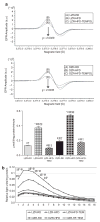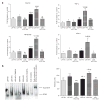Diet-induced renal changes in Zucker rats are ameliorated by the superoxide dismutase mimetic TEMPOL
- PMID: 19424163
- PMCID: PMC2784093
- DOI: 10.1038/oby.2009.137
Diet-induced renal changes in Zucker rats are ameliorated by the superoxide dismutase mimetic TEMPOL
Abstract
Diabetic nephropathy is the leading cause of renal failure in the United States. The obese Zucker rat (OZR; fa/fa) is a commonly used model of type 2 diabetes and metabolic syndrome (MetS), and of the nephropathy and renal oxidative stress commonly seen in these disorders. Heterozygous lean Zucker rats (LZRs; fa/+) are susceptible to high-fat diet (HFD)-induced obesity and MetS. The present study was designed to investigate whether 4-hydroxy-2,2,6,6-tetramethylpiperidine-N-oxyl (TEMPOL), a membrane-permeable radical scavenger, could alleviate the renal effects of MetS in OZR and LZR fed a HFD, which resembles the typical "Western" diet. OZR and LZR were fed a HFD (OZR-HFD and LZR-HFD) or regular diet (OZR-RD and LZR-RD) and allowed free access to drinking water or water containing 1 mmol/l TEMPOL for 10 weeks. When compared to OZR-RD animals, OZR-HFD animals exhibited significantly higher levels of total renal cortical reactive oxygen species (ROS) production, plasma lipids, insulin, C-reactive protein, blood urea nitrogen (BUN), creatinine (Cr), and urinary albumin excretion (P < 0.05); these changes were accompanied by a significant decrease in plasma high-density lipoprotein levels (P < 0.05). The mRNA expression levels of desmin, tumor necrosis factor-alpha (TNF-alpha), nuclear factor kappaB (NFkappaB), and NAD(P)H oxidase-1 (NOX-1) were significantly higher in the renal cortical tissues of OZR-HFD animals; NFkappaB p65 DNA binding activity as determined by electrophoretic mobility shift assay was also significantly higher in these animals. The same trends were noted in LZR-HFD animals. Our data demonstrate that TEMPOL may prove beneficial in treating the early stages of the nephropathy often associated with MetS.
Conflict of interest statement
The authors declared no conflict of interest.
Figures




References
-
- Reaven GM. Banting lecture 1988. Role of insulin resistance in human disease. Diabetes. 1988;37:1595–1607. - PubMed
-
- Grundy SM, Cleeman JI, Daniels SR, et al. Diagnosis and management of the metabolic syndrome: an American Heart Association/National Heart, Lung, and Blood Institute Scientific Statement. Circulation. 2005;112:2735–2752. - PubMed
-
- Mundy AL, Haas E, Bhattacharya I, et al. Fat intake modifies vascular responsiveness and receptor expression of vasoconstrictors: implications for diet-induced obesity. Cardiovasc Res. 2007;73:368–375. - PubMed
-
- Schena FP, Gesualdo L. Pathogenetic mechanisms of diabetic nephropathy. J Am Soc Nephrol. 2005;16(Suppl 1):S30–S33. - PubMed
Publication types
MeSH terms
Substances
Grants and funding
LinkOut - more resources
Full Text Sources
Medical
Research Materials
Miscellaneous

